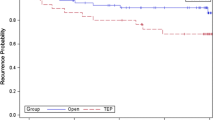Abstract
Background
The aim of this prospective randomized multicenter trial was to evaluate the recurrence rates and complications of open versus laparoscopic repairs of inguinal hernias.
Methods
Patients with primary unilateral inguinal hernias were randomized to Shouldice repair, Bassini operation, tension-free hernioplasty (Lichtenstein repair), laparoscopic transabdominal extraperitoneal hernioplasty (TEP), or laparoscopic transabdominal preperitoneal hernioplasty (TAPP). The primary outcome parameter was the rate of recurrence at 3 years. The secondary outcome was the rate of intraoperative, perioperative, and long-term complications. Follow-up comprised of clinical examination after 1, 2, and 3 years.
Results
Three hundred and sixty-five patients were randomly assigned to one of the five procedures. The intention-to-treat analysis showed that the cumulative 3-year recurrence rate was 3.4% in the Bassini group, 4.7% in the Shouldice group, 0% in the Lichtenstein group, 4.7% in the TAPP group, and 5.9% in the TEP group (p = 0.48). Comparing open (Bassini, Shouldice, Lichtenstein) versus laparoscopic (TAPP, TEP) techniques (p = 0.29) and comparing the use of mesh prostheses (Lichtenstein, TAPP, TEP) versus suturing techniques (Bassini, Shouldice) (p = 0.74) showed no significance in the rate of recurrence. The rates of intraoperative (p = 0.15), perioperative (p = 0.09), and long-term complications (p = 0.13) were without significance between the five groups. Comparing mesh techniques (Lichtenstein, TAPP, TEP) versus suturing techniques (Bassini, Shouldice) showed no significance in the rate of complications. The per-protocol analysis for the comparison of mesh (Lichtenstein, TAPP, TEP) versus suturing (Bassini, Shouldice) techniques revealed that recurrences (p = 0.74), intraoperative (p = 0.64), perioperative (p = 0.27), and long-term complications (p = 0.91) were evenly distributed.
Conclusions
In this multicenter study, no significant difference in the recurrence rate and complications between laparoscopic and open methods of hernia repair was revealed.
Similar content being viewed by others
References
Ger R (1982) The management of certain abdominal herniae by intra-abdominal closure of the neck of the sac. Preliminary communication. Ann R Coll Surg Engl 64:342–344
Liem MS, van der Graaf Y, van Steensel CJ, Boelhouwer RU, Clevers GJ, Meijer WS, Stassen LP, Vente JP, Weidema WF, Schrijvers AJ, van Vroonhoven TJ (1997) Comparison of conventional anterior surgery and laparoscopic surgery for inguinal-hernia repair. N Engl J Med 336:1541–1547
[No authors listed] (1999) Laparoscopic versus open repair of groin hernia: a randomised comparison. The MRC Laparoscopic Groin Hernia Trial Group. Lancet 354:185–190
McCormack K, Scott NW, Go PM, Ross S, Grant AM; EU Hernia Trialists Collaboration (2003) Laparoscopic techniques versus open techniques for inguinal hernia repair. Cochrane Database Syst Rev 1:CD001785
Fitzgibbons RJ Jr, Camps J, Cornet DA, Nguyen NX, Litke BS, Annibali R, Salerno GM (1995) Laparoscopic inguinal herniorrhaphy. Results of a multicenter trial. Ann Surg 221:3–13
Amid PK, Shulman AG, Lichtenstein IL (1996) Open “tension-free” repair of inguinal hernias: the Lichtenstein technique. Eur J Surg 162:447–453
Smith CD (1997) Inguinal herniorrhaphy: posterior buttressed mesh repair via laparoscopy (TEP). Video, American College of Surgeons CC-1866, Ciné-Med, Woodbury, Connecticut
Fitzgibbons RJ Jr (1997) Transabdominal preperitoneal laparoscopic inguinal herniorrhaphy. Video, American College of Surgeons CC-1871, Ciné-Med, Woodbury, Connecticut
Payne JH Jr, Grininger LM, Izawa MT, Podoll EF, Lindhal PJ, Balfour J (1994) Laparoscopic or open inguinal herniorrhaphy? A randomized prospective trial. Arch Surg 129:973–981
Lichtenstein IL, Shulman AG, Amid PK, Montllor MM (1989) The tension-free hernioplasty. Am J Surg 157:188–193
Memon MA, Cooper NJ, Memon B, Memon MI, Abrams KR (2003) Meta-analysis of randomized clinical trials comparing open and laparoscopic inguinal hernia repair. Br J Surg 90:1479–1492
Pokorny H, Klingler A, Scheyer M, Függer R, Bischof G (2006) Postoperative pain and quality of life after laparoscopic and open inguinal hernia repair: results of a prospective randomized trial. Hernia 10:331–337
Neumayer L, Giobbie-Hurder A, Jonasson O, Fitzgibbons R Jr, Dunlop D, Gibbs J, Reda D, Henderson W; Veterans Affairs Cooperative Studies Program 456 Investigators (2004) Open mesh versus laparoscopic mesh repair of inguinal hernia. N Engl J Med 350:1819–1827
Author information
Authors and Affiliations
Corresponding author
Rights and permissions
About this article
Cite this article
Pokorny, H., Klingler, A., Schmid, T. et al. Recurrence and complications after laparoscopic versus open inguinal hernia repair: results of a prospective randomized multicenter trial. Hernia 12, 385–389 (2008). https://doi.org/10.1007/s10029-008-0357-1
Received:
Accepted:
Published:
Issue Date:
DOI: https://doi.org/10.1007/s10029-008-0357-1




